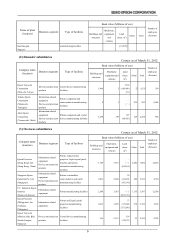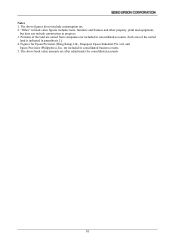Epson 2012 Annual Report Download - page 20
Download and view the complete annual report
Please find page 20 of the 2012 Epson annual report below. You can navigate through the pages in the report by either clicking on the pages listed below, or by using the keyword search tool below to find specific information within the annual report.
19
21. Epson might be severely affected in the event of a natural or other disaster.
Epson has research and development, procurement, manufacturing, logistics, sales and services sites around the
globe. It is possible that the regions concerned could be affected by any number of unpredictable events, such as
a natural disaster, computer virus, outbreak of an influenza pandemic, leak of customer data, supply chain
disruption resulting from damage to parts suppliers, act of terrorism or war, and that these could adversely affect
Epson's operating results.
The central region of Nagano Prefecture, where Epson has sites for its primary businesses, has numerous cities
and towns designated as "Areas Requiring Enhanced Measures to Respond to Disasters" due to the high risk of a
large-scale disaster in the event of an earthquake in the Tokai region. Moreover, an active fault line traces the
Itoigawa Shizuoka geotectonic line through the middle of the Nagano Prefecture region.
The areas classifiable as Areas Requiring Enhanced Measures to Respond to Disasters in Earthquakes were
revised in April 2002, so Epson had to revise its earthquake-response policy, look into strengthening numerous
buildings that were not built to resist earthquakes, take measures to avoid losses of materials for important parts,
and create plans to prevent damage from earthquakes. Epson is also conducting other countermeasures such as
partially dispersing its manufacturing sites throughout other regions.
However, if a major earthquake occurs in the central Nagano Prefecture region, it is possible that, despite these
countermeasures, the effect on Epson could be extreme.
Although Epson is insured against losses arising from earthquakes, the scope of indemnification is limited.
22. Laws and regulations pose risks for Epson.
Some of Epson's businesses involve products that require legal or regulatory approval or licenses. Plastic
corrective lenses, for example, are subject to regulation by certain authorities as they are considered medical
equipment in Japan. Such products only represent a small percentage of Epson’s total net sales or income, but
Epson is subject to the approval and regulatory requirements of relevant authorities in its manufacturing and
manufacturing/sales of those products in Japan.
Also, because the plastic corrective lenses, which are manufactured by Epson, are sold in the United States,
Europe and Asia by a sales subsidiary of Seiko Holdings, Epson is also subject to certain regulations in these
regions. For example, relevant authorities in the United States generally make it compulsory to carry out tests of
these products and to keep designated records relating to them.
Regulations governing medical devices in Japan, the United States and other regions have changed in the past, so
there is a possibility that they will change again in the future. If they do, there is a possibility the changes might
impede the manufacture and sale of Epson’s products and thereby adversely affect Epson’s operating results.
























